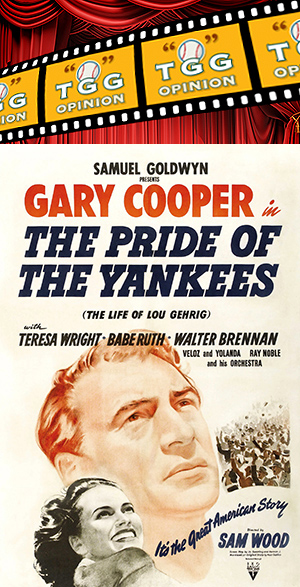TGG OPINIONS
“The Pride of the Yankees”
The TGG Baseball Movie Review
Gary Cooper plays the Iron Horse bumbling his way toward fame before tragedy strikes in the kind of movie they don’t make anymore—and thank goodness for that.
From Ed Attanasio:
 As long as I can remember, my father would tell me that the greatest baseball player who ever lived was Lou Gehrig, the Iron Horse. Every time I got hurt doing something stupid and would whine about it, he would remind me about Gehrig’s amazing record of playing rain or shine, injured or not. After a while, I started thinking about the Iron Horse like a hero from Greek mythology—the Zeus of baseball.
As long as I can remember, my father would tell me that the greatest baseball player who ever lived was Lou Gehrig, the Iron Horse. Every time I got hurt doing something stupid and would whine about it, he would remind me about Gehrig’s amazing record of playing rain or shine, injured or not. After a while, I started thinking about the Iron Horse like a hero from Greek mythology—the Zeus of baseball.
So, when my dad and I watched this film together more than 40 years ago, I remembered liking it. But, after streaming it the other day, I discovered that I am not crazy about it anymore. While I was in awe as a child with the great Gary Cooper playing Gehrig, now his performance seems flat and the movie in general is lifeless and a real downer.
I guess my main objection with The Pride of the Yankees is that it spends too much time playing tribute to the man and not enough building a story or developing any characters we can really care about. So in the end, I was sitting there just waiting for him to get sick. That’s how unexciting the first four-fifth’s of the movie was for me.
They say that every story needs a hero and a villain, a romance and at least one inciting moment. We know the hero, but the antagonist in this film is a fatal disease and it’s hard to hate a disease, because it has no dialogue and can’t sit in the shadows and say evil things.
Big Lou’s romance with his eventual wife (played by Teresa Wright) consists of her dropping cute little quips and Cooper acting shy and clumsy and it gets old real quick. So, even the love interest part of the film seems sugar coated. Didn’t these two ever get in a quarrel or two? Seems not, but anyone who is married knows that isn’t realistic.
Fortunately, Ma & Pa Gehrig (played by Elsa Johnson and Ludwig Stossel) are a pure delight and offer us some rare moments of levity. And seeing all of the old stadiums (one was actually Wrigley Field in Los Angeles) and some Yankee players (Babe Ruth, Bill Dickey and Mark Koenig) is a lot of fun. But, to sit through this tribute to a player who had no vices or drama in his life (until the end) is a snoozer, even for a huge baseball fan like me.
Whenever I watch a baseball film, I always look for actors who actually appear as though they played the game. If an actor can’t throw a baseball (Example—Fear Strikes Out, the Jimmy Piersall story played by Anthony Perkins) or if anything in the film does not look authentic, I can’t get into the story. In The Pride of the Yankees, Gary Cooper is fairly believable as a player, but I believe that they limited his baseball scenes to mask the fact that he didn’t play a lot of baseball as a kid. To do this, we see a lot of montages–quick, tightly edited glimpses of games and crowds and our smiling Iron Horse doing little.
 Also, the age discrepancies were pretty obvious. Cooper plays Gehrig as a college student at Columbia but he looked at least 35 years old. Plus, his parents looked ancient even early in the film when Gehrig was a child. Couldn’t they have at least attempted to make them look a little younger, to provide a little bit of that old “suspension of disbelief”? I don’t know why these things are important to me, because the film is more of a fable anyway, but they do.
Also, the age discrepancies were pretty obvious. Cooper plays Gehrig as a college student at Columbia but he looked at least 35 years old. Plus, his parents looked ancient even early in the film when Gehrig was a child. Couldn’t they have at least attempted to make them look a little younger, to provide a little bit of that old “suspension of disbelief”? I don’t know why these things are important to me, because the film is more of a fable anyway, but they do.
So yes—I have become more skeptical and less of a fun guy as I’ve aged, but seeing Lou’s famous farewell speech at the conclusion of The Pride of the Yankees made me cry like a baby…again. I admit it.
Was I crying because I just wasted two hours re-watching this movie? No, but I sure as heck did not consider myself the luckiest man on the face of the earth either.
From Eric Gouldsberry:
Ed touches on the appearance of actual Yankees players—most prominently Babe Ruth and Bill Dickey—and it’s interesting to see how their acting chops are so surprisingly good, they give the film a touch of realism that transcends the over-polished performances of the lead players. This serves to remind us that The Pride of the Yankees is a good old-fashioned biopic churned out in a golden era of moviemaking when Hollywood mixed glamour and golly-gee-shucks enthusiasm and escapism.
The Pride of the Yankees is a safe film. It doesn’t press the edges like, say, an earlier RKO effort, the great Citizen Kane—which is interesting given that Herman J. Mankiewicz co-wrote both films. But The Pride of the Yankees also doesn’t skip a beat and manages to succeed on its own terms. It’s unapologetic in depicting—or stereotyping, perhaps—Lou Gehrig as a bumbling force of wholesome human purity. He’s given the perfect mate in Mrs. Gehrig, portrayed by Teresa Wright as the perfect wife we should all be so lucky to have.
Has this film dated? Of course it has. Any remake today would be more honest, darker and substantive. The dramatic undercurrent of The Pride of the Yankees, as Ed notes, is all but absent for a good chunk of the film’s running time, with only modest tension provided through the relationships cast by Gehrig’s mother (Elsa Johnson, borrowing from Jane Durwell’s Ma Joad in The Grapes of Wrath). And when Gehrig does begin to fall ill, the movie seems to fast-forward through it, abridging the adversity by focusing on the good times that precede it. But for the filmmakers, death is not doted on here but, as the opening scroll states, “the story of a hero of the peaceful paths of everyday life.”
Granted, there are moments that get so hopelessly hokey that you expect the silhouettes of the Mystery Science Theater critters to pop up in the corner and start making jokes. A few gratuitous musical numbers midway in serve as an unofficial intermission for viewers to run out and take care of business—but worse comes the scene where Gehrig sneaks into a hospital room to greet a dying young baseball fan who, just moments before, had been promised a home run on the day by Babe Ruth. Gehrig doubles down and promises two homers, and the ensuing conversation gets so sappy and borderline laughable for anyone who recalls Airplane! and the hilarious exchange between pilot Peter Graves and a young cockpit visitor. You know, the one where Graves peppers the kid with questions like, “Joey, you ever hang out in gymnasiums?”
So pardon the schmaltz, and you’ll find yourself enjoying The Pride of the Yankees. The Academy Awards sure did; the film was nominated for ten Oscars including Best Picture, winning one for editing. Among the nominees were Gary Cooper, who’s at his best playing the older Gehrig—like Ed, I found it dubious seeing a 20-year old Gehrig through the 40-year-old skin of Cooper—and Wright, nominated for two films that year—winning for her other performance in Mrs. Miniver. Not nominated and snubbed was William Cameron Menzies, the brilliant visualist who shares on-screen credit space with director Sam Wood and is most certainly responsible for the film’s epic look, expertly revealing ballparks, homes and other settings as places that seem to come alive with the people that inhabit them. Anyone who’s seen Things to Come, Our Town and Invaders From Mars will know what I’m talking about.
 For hardcore baseball historians, you’ll have to excuse The Pride of the Yankees’ factual shortcomings. Gehrig never promised a kid two homers. And he was hardly the clumsy, naive unknown as depicted in the film; he had, in fact, been the object of a tug-of-war between the Yankees and New York Giants and made headlines with impressive feats pre-Yankees, such as when he belted a grand slam completely out of Wrigley Field during a high school All-Star game at age 17.
For hardcore baseball historians, you’ll have to excuse The Pride of the Yankees’ factual shortcomings. Gehrig never promised a kid two homers. And he was hardly the clumsy, naive unknown as depicted in the film; he had, in fact, been the object of a tug-of-war between the Yankees and New York Giants and made headlines with impressive feats pre-Yankees, such as when he belted a grand slam completely out of Wrigley Field during a high school All-Star game at age 17.
Good baseball films—heck, baseball films in general—are few and far between through Hollywood’s first 50 years, but The Pride of the Yankees is, warts, sentimentality and all, among the best of the lot.




